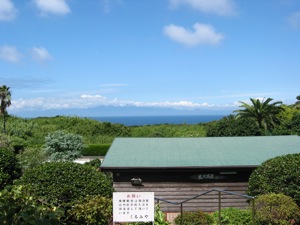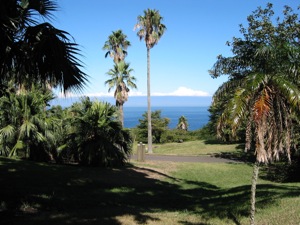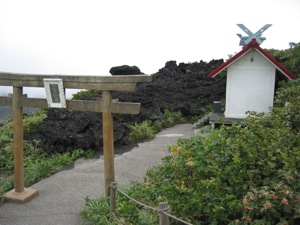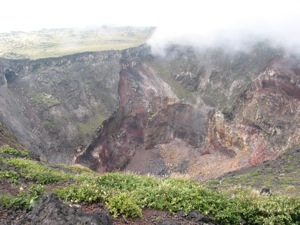
October 11th 2008
As the global economy collapses, I continue my efforts to bring my diary up to date. That would be a bit like fiddling while Rome burned, if I had any influence at all over banking or stock markets. As I don't, however, I think it's perfectly reasonable. I do wonder how the crash is going to affect me, but I really have no idea at all. Since the experts don't seem to know what's going to happen on a global scale, I think it would be foolish to suppose that I could have any idea about its impact on me personally. Another reason for concentrating on writing about good stuff.
So, as I mentioned a couple of days ago, Yuriko and Mayuki stayed in the UK for a week after I left, and I gather that they had a really good time. When they came back my Mum came with them, to stay in Japan for a couple of weeks and spend more time with Mayuki. Most of the time I had to work, as you might expect, but we did take one long weekend away, and that will be the main topic of this entry.
Izu Ohshima
We went to Izu Ohshima, which means "Izu Big Island". There is a chain of volcanic islands running south from the Japanese mainland quite close to us, known as the Izu islands. They used to be part of Izu, now the eastern part of Shizuoka Prefecture, but they were administratively transferred to Tokyo some time ago, with the result that all the islands are formally part of Japan's capital. It's as if the Scilly Isles were part of Greater London, rather than Cornwall. Being relatively small islands (Ohshima is the biggest at ninety square kilometres), they are very different from most of Tokyo in atmosphere, appearance, and, indeed, just about every respect.
 The view from the lobby of Kurumiya
The view from the lobby of Kurumiya
As it is an island, and too far for a bridge, you have to get a boat or plane to get there. We went by boat, actually a hydrofoil, which left from Tokyo. We had to get up really, really early in the morning to get it, but we all managed it, and the trip out was fairly calm, so there were no problems with sea sickness. Mayuki quite enjoyed the trip, although she did keep changing her mind about whom she wanted to hold her. We left in grey weather with light rain, which was slightly better than the preceding few days, when the rain had been heavy. As we approached the island, though, the weather started brightening up, until it was really quite sunny by the time we arrived at the ryokan, Kurumiya.
They sent a minibus to meet us from the boat, and drove us up to the roykan itself. The view from the lobby was great, as you can see from the picture. Not only is the Izu peninsular on the horizon, you can see Mount Fuji on a clear day. The building in the foreground is the changing block for the outdoor hot spring bath. As I mentioned above, the islands are volcanic. Ohshima is one of the three biggest basalt shield volcanoes in the world, the others being Stromboli and one of the Hawaiian volcanoes. It's also still active; the last significant eruption was in 1986. I mention that because, apparently, Kurumiya didn't have a hot spring in 1985, just an ordinary cold spring. Even the eruption of the island was good for at least one business there.
A discussion with the ryokan staff convinced us that it would be best to rent a car, and I'm glad we did. The island is big enough that you certainly can't walk everywhere, and the buses are not terribly frequent. Having a car gave us the freedom to go and see everything we wanted to. In fact, I think we managed to see all the main attractions on the island.
Ohshima Park
 Looking across Ohshima Park to the Pacific Ocean.
Looking across Ohshima Park to the Pacific Ocean.
On the first day, after arriving, we had lunch at a nice restaurant recommended in the guidebook, and then went on round the northern part of the island to Ohshima Park. This park is maintained by the Tokyo Metropolitan Government, and it's glorious. We only got to see part of it on the first day, having a very nice walk through the managed park, and then along a coastal path. There were no beaches at this point, as the coast was all cliffs, and we could hear the waves breaking against them as we walked, catching sight of the rocks and waves between the trees at various points.
The only problem with the walk was that the route marked on the map turned out to be closed, due to building work, so that we couldn't go round in a loop and back to the car. Instead, we had to retrace our steps, and then went a bit further to come back through the park from another direction. It was all a nice walk, and if I hadn't been carrying Mayuki (who slept through most of it), it would have been no problem at all. As it was, I was very glad to get a sit-down when we got back to the car park.
The park was almost empty while we were there, even though it was a Sunday. It was, however, the end of the summer tourist season (they have a winter one as well), and the total population of Ohshima is only about 9,000, so it's not that surprising. In addition, the park is quite some distance from the main towns, and the largest one, Motomachi, is right the other side of the island. Since you can't go over the middle of the island (there's a volcano there), that makes it quite a distance.
On the way back to the ryokan, we stopped off at Okata, a fishing port on the north coast, to have a look at that one. We looked in at one of the shrines there, but it was populated by a very large number of mosquitoes, so we didn't stay long.
Back at the ryokan, we were able to check into our rooms. We all had large rooms, with a great view out over the sea. Dinner was also very nice, which continued throughout our stay, and Mayuki was a big hit with the staff. It turned out that the manager's sister is married to an Englishman and living in the UK; it really is quite a small world these days.
Mihara Yama
The next day, the weather was reasonable and the forecast quite good, so we decided to climb the volcano. This is a perfectly normal thing to do, and it's only a hiking course, not actual mountain climbing. It's not even particularly strenuous hiking, although it is rather more than just a stroll. You can drive quite a long way up, and then park at a point with shops and a police point. I suspect that the main job of the policeman is evacuating tourists on the volcano if it decides to erupt; there is a metalled path running from the car park to the mountain, which I think the car we saw could drive along. There were also a number of concrete shelters dotted around, for hiding in if the volcano got violent. Fortunately, it was well-behaved while we were there. I had to explain to Yuriko that actually, for well-monitored volcanoes, particularly of this kind, scientists can predict eruptions a few days in advance, so there wasn't really anything to worry about. It was reassuring to see all the monitoring equipment in place, however.
From the car park, you walk down and then across a lava plain. On one side of the path, the flows are 200 years old, on the other, fifty. The difference in vegetation is quite noticeable, and when you reach the flow from twenty years ago that's very noticeable once again. After the lava plain, the path zig-zags up the side of the volcanic cone, and it's quite steep. Every so often there are signs encouraging you to keep going, and benches where you can get a little rest.
 Mihara Shrine, with the lava flow behind it. The shrine was there first.
Mihara Shrine, with the lava flow behind it. The shrine was there first.
On the top of the mountain, just below the peak, is a small shrine, to the volcano. The shrine was there when the volcano last erupted. It's still there now. A lava flow just missed the shrine, curling round to define an area in front for paying your respects. (The lava flow is the black bit in the picture.) The shrine now has a good reputation for prayers to avoid disasters, for fairly obvious reasons. The shrine is not, incidentally, made of wood. It wasn't that much of a miracle.
At the top of the volcano, there is a path going round the top of the cone, and we decided to walk round. It took a lot longer than anticipated, and was very steep in places, but I'm very glad we did it, because it meant that we got to see the crater up close.
 The main crater on Miharayama.
The main crater on Miharayama.
I'd never seen a real volcanic crater before. It was still steaming, and the crater walls were more colourful than I'd imagined, with reds, yellows, blacks, and greens, the green being where plants had already started to colonise. There was no glowing lava, which was probably a good thing, all told, but there was steam coming out of the ground, reminding us that this volcano is very definitely still active.
We saw photographs of the 1986 eruption, with fire towering over the island, and the raining down. When there is an eruption, I believe everyone is evacuated to the mainland until it is safe to return; one of the other islands in the chain, Miyakejima, had an eruption about five years ago, and the inhabitants have only recently been able to go back. Standing on top of the volcano, it was quite easy to imagine just how furious it could be, especially when looking around at the visible lava flows.
However, they weren't always visible. The top of the volcano is about 750 metres, and we spent part of our time walking round enveloped in cloud. (The "smoke" in the photograph of the crater is actually cloud.) That was actually quite a pleasant experience, as the rest of the world seemed to vanish, leaving us alone with the elements: earth, air, fire, and water. I did check with people working at the car park as to whether it was safe to go up in the clouds, but the path is very clear so it's no problem. You would have to make a serious effort to get lost, no matter how thick the cloud became, and if you were willing to make that sort of effort, you wouldn't need the cloud.
After our walk around the crater, we had to walk back to the car park. I had been carrying Mayuki all the way, sometimes asleep, and sometimes awake and trying to feed me her bottle, so I was very tired by the time we got back to the car, and very glad that I could put Mayuki in a baby seat and sit down. Another bonus to renting a car. Then we tried to go for lunch. This turned out to be harder than anticipated, as most places had closed before we got back from the peak. We did find somewhere eventually, however: the ferry terminal in Motomachi. It was quite a late lunch in the end, and as far as I remember we went back to the ryokan and just took it easy before dinner, as we were all quite tired. We'd also managed to get sunburn, despite the cloud. Mayuki was fine, because we'd put her sunscreen on, but we hadn't done our own. Oops...
I was hoping to do the whole of Ohshima today, but I have to teach in a few minutes, so I don't have time. I'll have to leave this here.